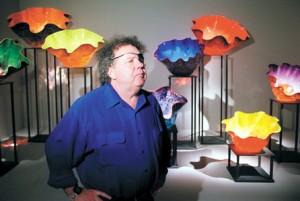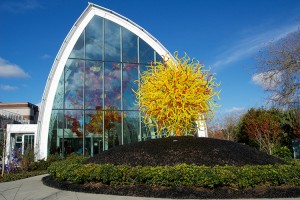Celebrating Glass from the Everyday to Chihuly
The United Nations named 2022 the international year of glass. Glass is one of the most useful materials in the world. Few manufactured substances add as much to modern living as does glass. Yet few products are made of such inexpensive raw materials. Glass is made chiefly from silica sand (silica, also called silicon dioxide), soda ash (sodium carbonate), and limestone (calcium carbonate).
Glass has countless uses. Food is preserved in glass jars. People drink from glass containers called glasses. Windows in homes, schools, and office buildings are glass. Motor vehicles have glass windshields and windows. People with vision problems wear eyeglasses. Glass optical fibers carry data all over the world at the speed of light over the Internet, the worldwide network of computers.
Besides being useful, glass is also ornamental. Ever since people learned how to make glass, they have used it as an art material. Glass can take many different forms. It can be spun finer than a spider web. Or it can be molded into a disk for a telescope lens or mirror weighing many tons. Glass can be stronger than steel, or more fragile than paper. Most glass is transparent, but glass can also be colored to any desired shade.

Glassmaking is a popular form of the decorative arts. Dale Chihuly is one of the leading glass artists in the United States. Some of Chihuly’s glass sculptures are shown in the background.
Credit: AP/Wide World
American artist Dale Chihuly is credited with bringing blown glass art back into fashion. Chihuly was born on Sept. 20, 1941, in Tacoma, Washington. He began glass blowing in 1965. Chihuly experimented with colors, layers, and organic forms. He quickly became the biggest name in glass blowing, teaching new artists how to challenge the norm of glass art. Much of Chihuly’s art is on display in public exhibitions. Glass baskets, bowls, chandeliers, orbs, and vases dominate Chihuly’s pieces.
One of Chihuly’s first public exhibitions was Chihuly over Venice, a project involving the installation of 15 chandeliers across Venice, Italy. His most notable works include DNA Tower (2003) in Indianapolis, Indiana, Citron Icicle Tower ( 2012) in Seattle, Washington, several displays at the Biltmore Estate in Asheville, North Carolina, and a colorful sculpture on the ceiling of the Bellagio Hotel in Las Vegas, Nevada.



